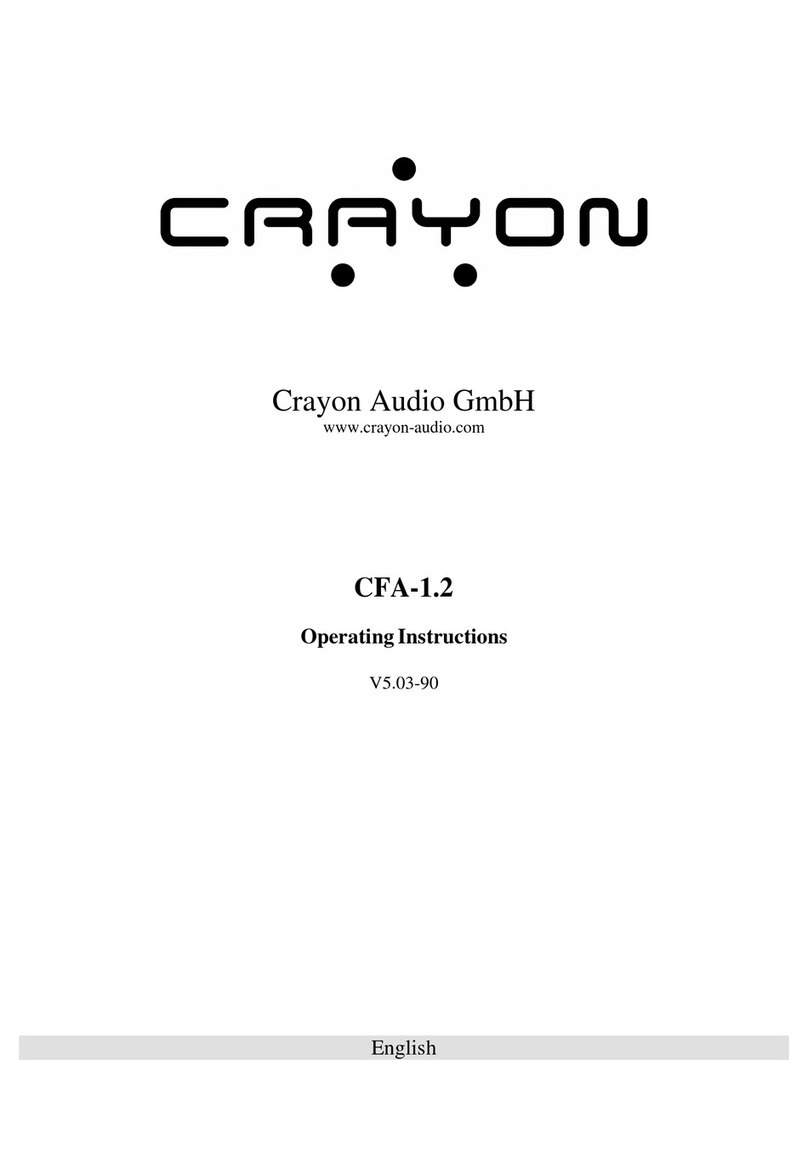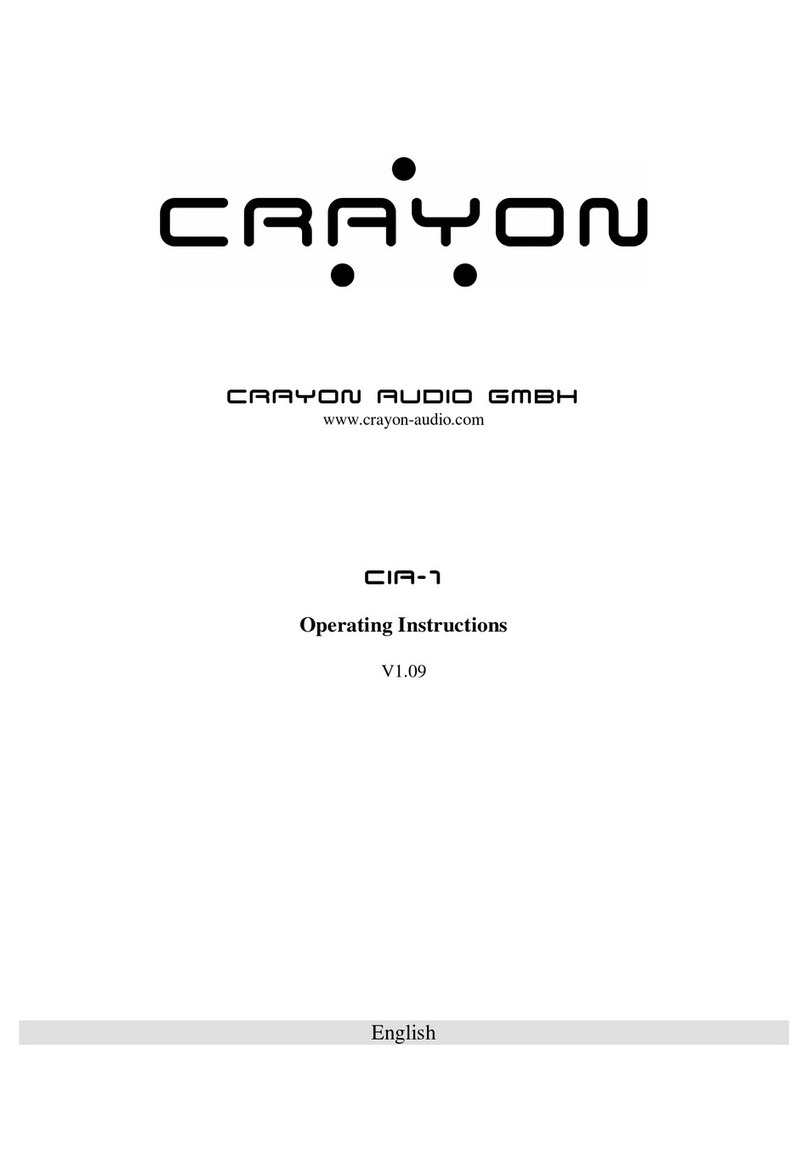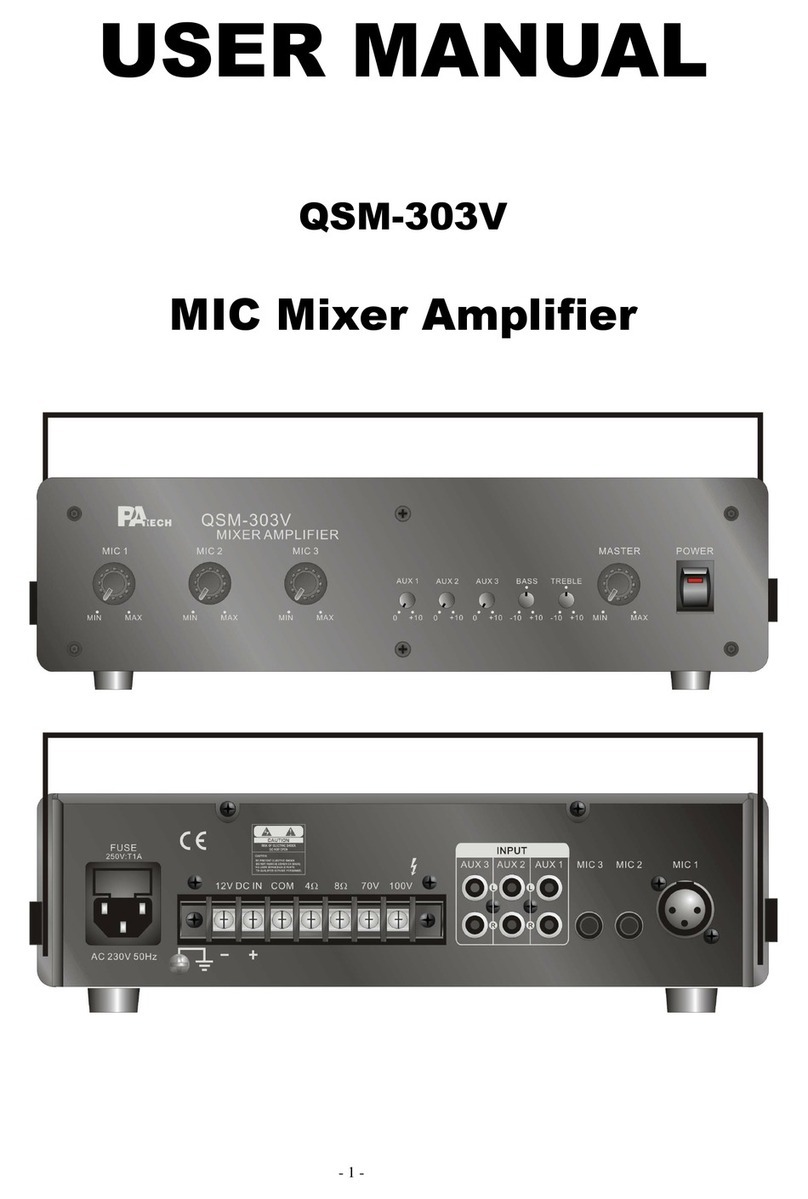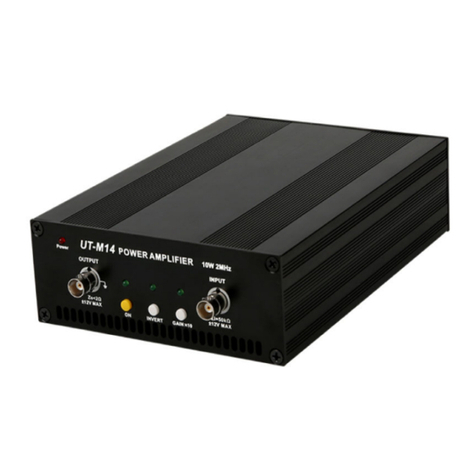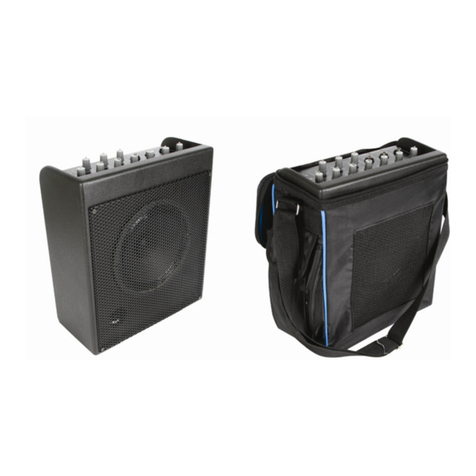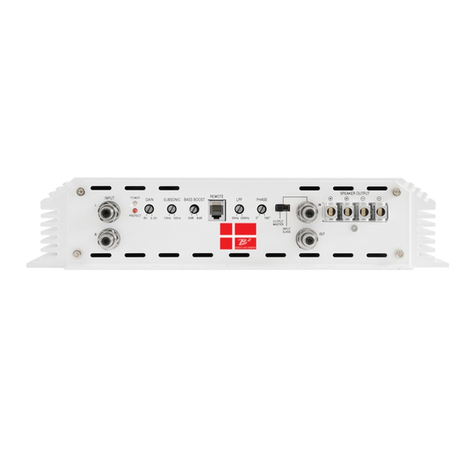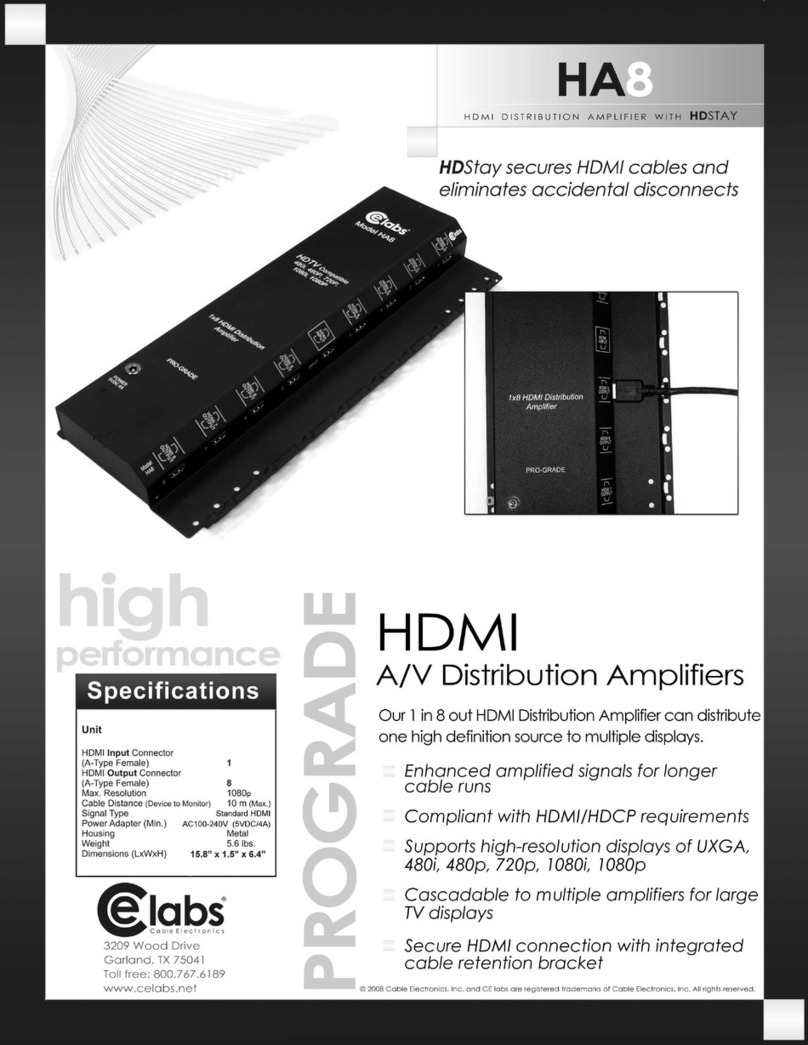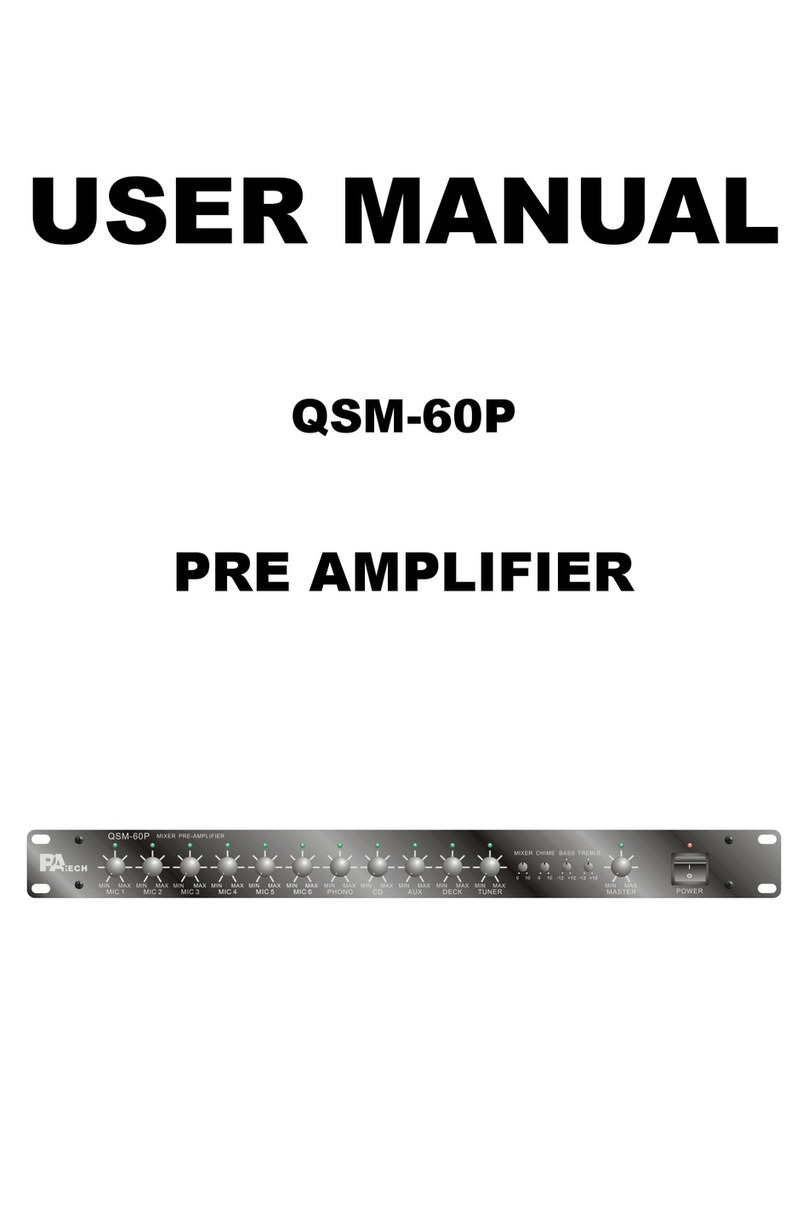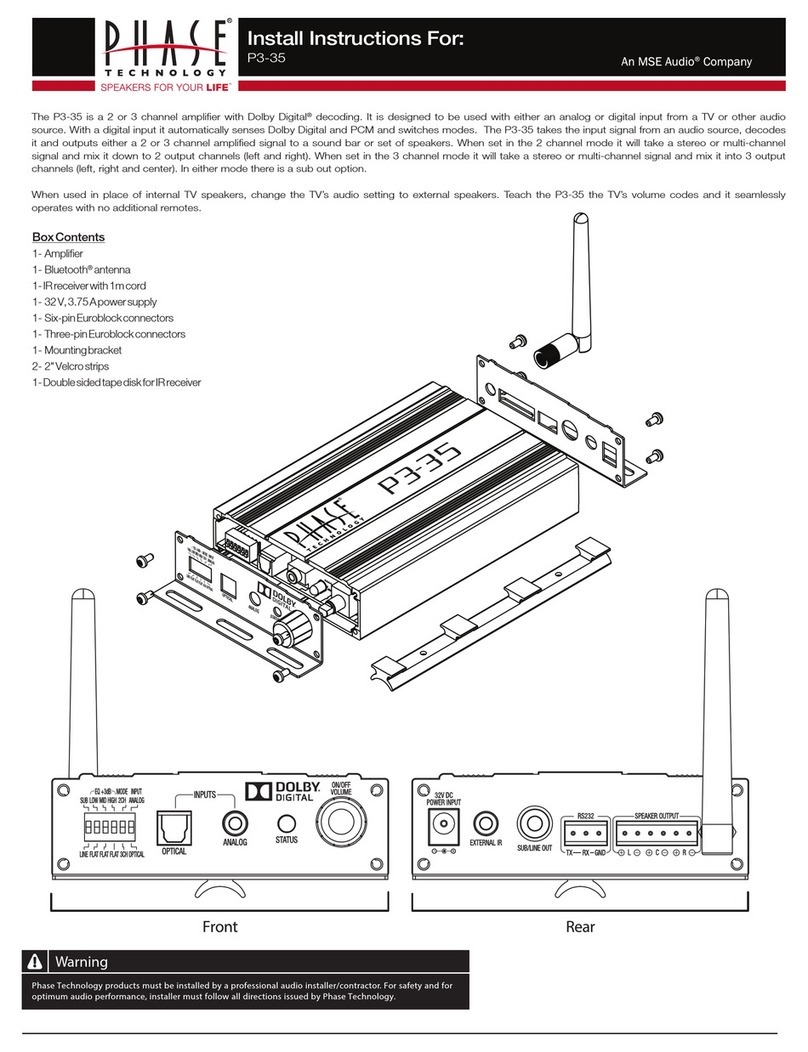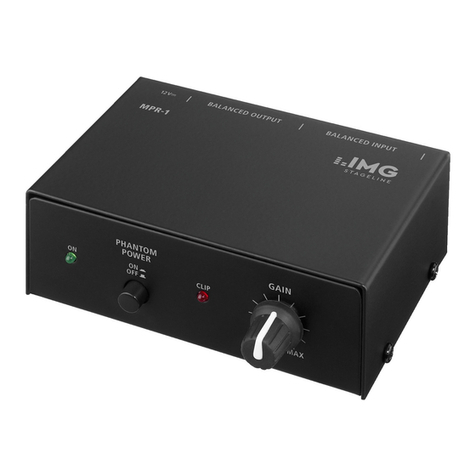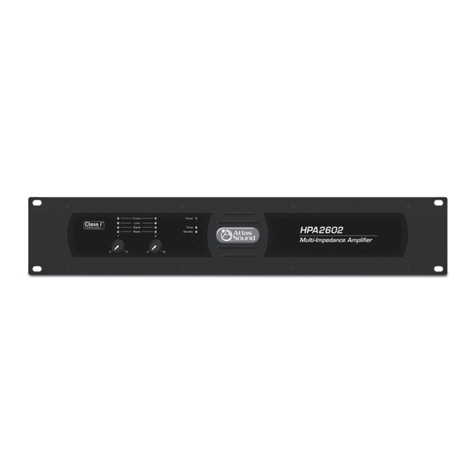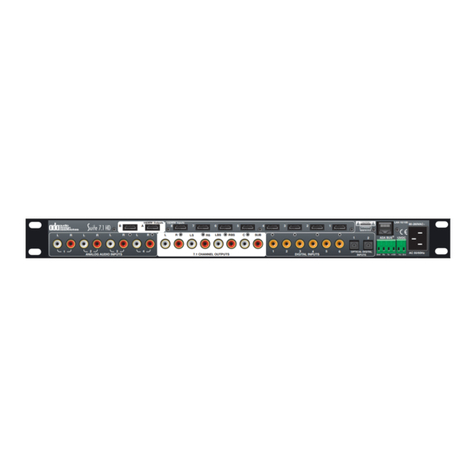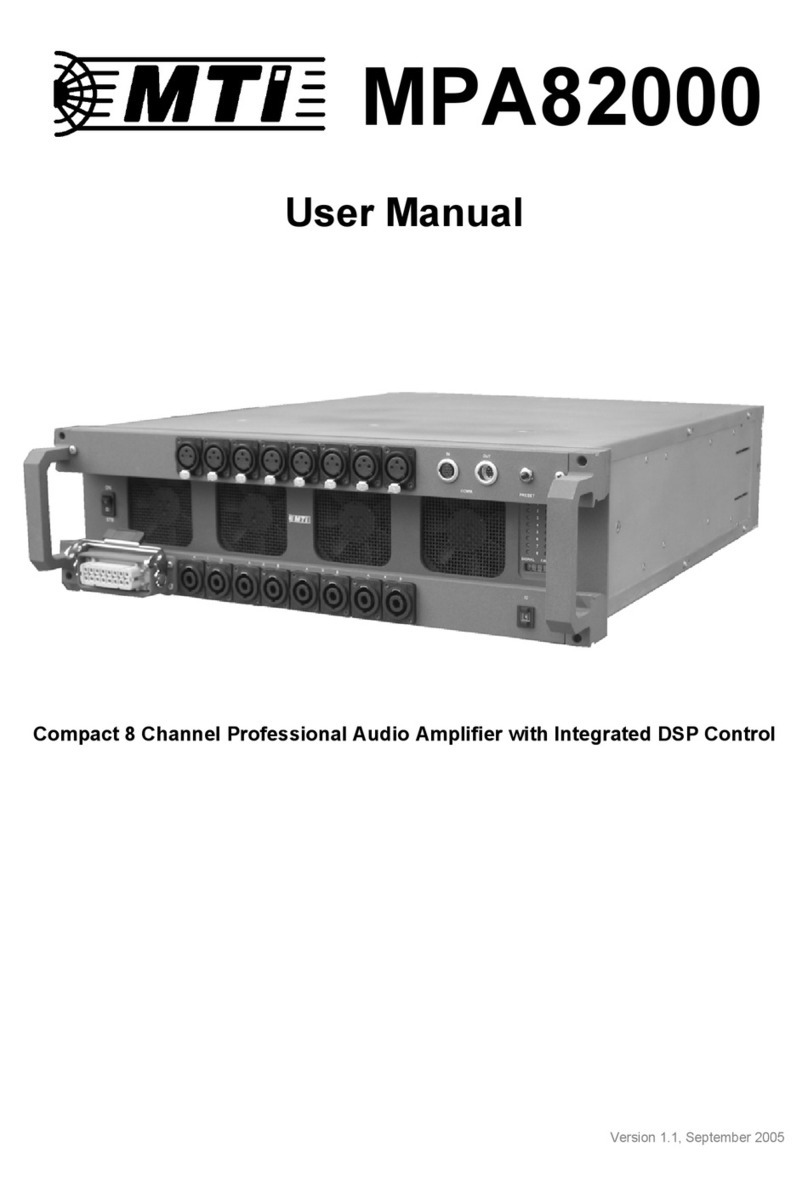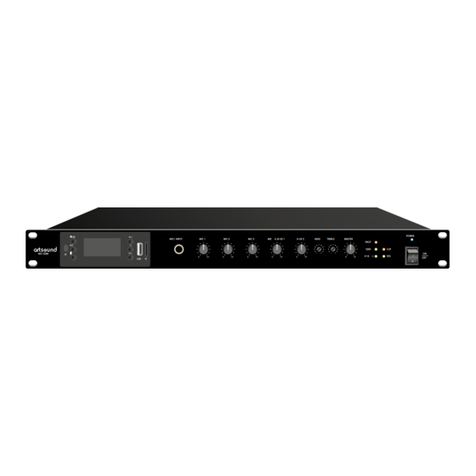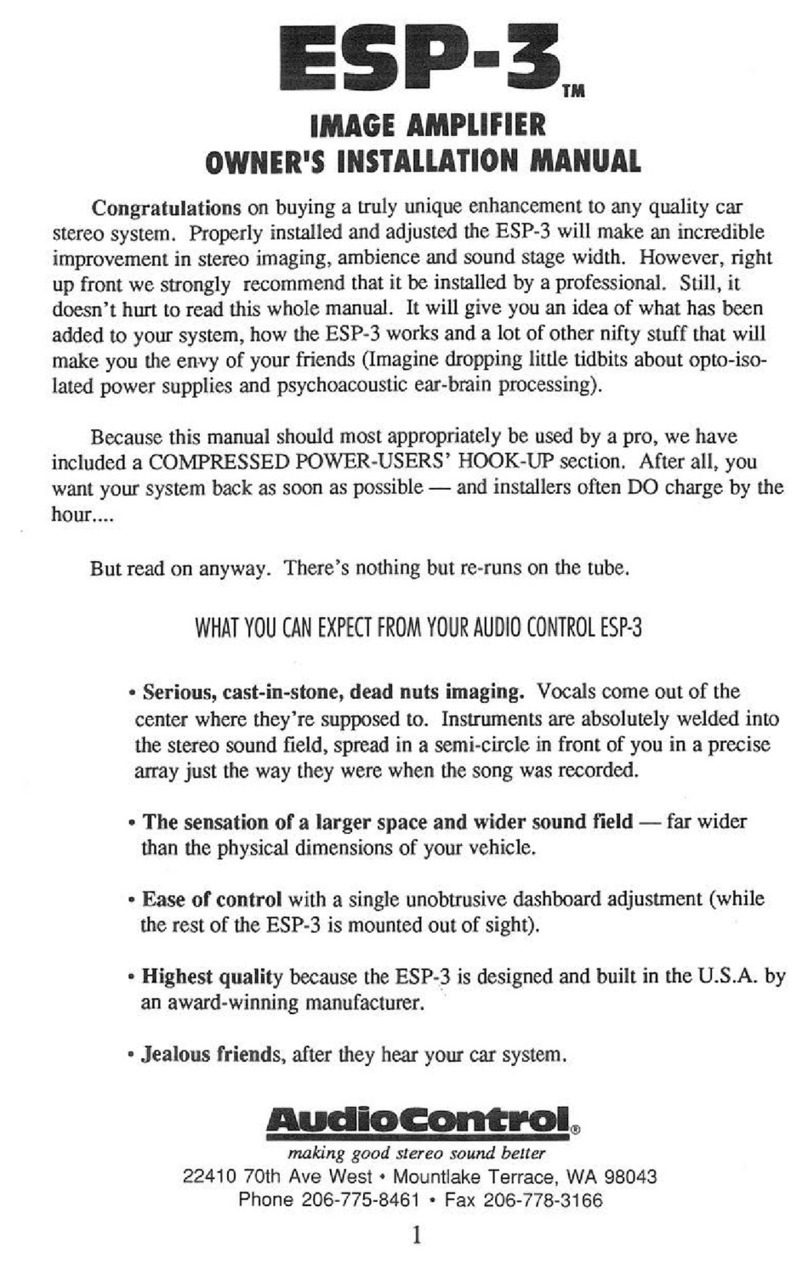Crayon Audio CIA-1T User manual

Crayon Audio GmbH
www.crayon-audio.com
CIA-1T
Operating Instructions
V2.00
English

2
CAUTION:
Subject to technical modifications!
Caution! The output stages are implemented as bridge circuits.
Therefore, all loudspeaker sockets carry a DC voltage of approx.
18V. The loudspeakers should NOT be connected to ground.
This would destroy your loudspeakers. Hence, the loudspeakers
should be connected only to banana sockets pairs.
The same colour markings
(red = + and black = -) are generally indicated on loudspeaker boxes.
An active subwoofer, which will be connected at the loudspeaker
outputs, must be galvanically decoupled !!!
Please look at the technical description of your subwoofer!
The CI
A
-
1
T
must be first switched to the Standby mode and
then disconnected from the Mains voltage, before connecting to
or disconnecting from the connectors at the back. Otherwise,
voltage surges may result which could damage the CIA-1T or
other components of the audio system or AV-systems
connected.
This device must be ear
thed. It is essential that the earthed power
cable with integrally cast plug provided be used. Never use an
unearthed plug or adaptor.
This device must
in
no case
be placed on a carpet
or other
similar surface. The heat sink is located on the device underside.
The fibers of the carpet would impede the circulation of the air
and the device runs hot. Please make the device only on smooth
surfaces (tabletop, shelf, wooden floor or similar).
PreAmp Output:
If you use the preamp output of the C
I
A
-
1
T
, please
note the following switch on sequence;
At first switch on the CIA-1T. Only after completion switch on operation,
then turn on the subsequent amplifier.

3
Copyright- and Trademark Notice
Copyright © Crayon Audio. First issued January 2015.
Crayon Audio GmbH, Hauptstrasse 169, 8141 Premstaetten, Austria.
Allrights reserved. Contents of this document may not be reproduced either wholly or partly, nor
entered into a database or transmitted in any form (by electronic or mechanical media, by photocopy,
recording or in other way) without prior written approval of the publisher.
Printed inAustria.
CIA-1T
,
Crayon Audio
and the Crayon logo are Trademarks of Crayon Audio GmbH
.
The contents of this manual have merely character of information. They can be changed without
previous announcement and may not be laid out as an obligation on the part of Crayon Audio GmbH.
Crayon Audio GmbH takes over no responsibility and assumes no liability for errors or inaccuracies,
which are possibly included in these operating instructions.
Technical changes reserved.

4
Table of Contents
CE Declaration of Conformity 5
Introduction 6
Unpacking
7
Voltage Selection
7
Cleaning
7
Connections 8-9
Basic Information 10-11
RemoteControl 12
Operation 13-15
Adaptor 16
Gain adjustment 17
Technical Data 18
Warranty and Customer Service 19-24
Important Safety Information 25
General Safety Information 26
Troubleshooting 27-28
Accessoires 29

5
Declaration of Conformity - CE Communauté Européenne
Declaration of Conformity CE-Communauté Européenne
Crayon Audio GmbH affirms that this product fulfils the requirements of the low-voltage guidelines 73 / 23 /
European Economic Community and the guidelines on electromagnetic compatibility 89 / 336 / European
Economic Community which was changed by the guidelines 92 / 31 / European Economic Community and 93 /
68 / European Economic Community. The conformity of the said product with the regulations of the guidelines 73
/ 23 / EEC (low-voltage guideline) is proved by total compliance to the following standards:
Standard / Date of Publication / Test
EN 60065 1998 General requirements Marking
Injurious radiation
Warming under normal conditions
Danger to touch under normal operation conditions
Isolation requirements Maloperation Mechanical rigidity
Parts with mains connection
Components
Terminal equipment
Electrical connections and mechanical mounting
Protection against electrical shock
Stability and mechanical risks
Fire resistance
The conformity of the said product with the regulations of the guideline 89 / 336 / European Economic
Community
(electromagnetic compatibility) is proved by total compliance to the following standards:
Standard / Date of Publication / Test
EN 60065 Audio, video and similar electronic apparatus – Safety requirements
EN 55013 Sound and television broadcast receivers and associated equipment Radio disturbance characteristics
Limits and methods of measurement
EN 55020 Sound and television broadcast receivers and associated equipment - Immunity characteristics - Limits
and methods of measurement
FCC-Notice:
Notice:
This device was tested according to part 15 of the FCC regulations and found to comply with the limits for Class
B digital devices. These limit values should guarantee an adequate protection against harmful disturbances if the
device is operated in residential areas. This device generates radio frequency energy and may cause interference to
radio and television reception. The device can disturb the radio traffic if it is not installed in accordance to
instructions and is used. However, there is no guarantee that interference will not occur in a particular installation.
If this equipment does cause interference to radio or television reception, which can be determined by turning the
equipment off and on, the user is encouraged to try to correct the interference by one or more of the following
measures:
• Reorient the receiving antenna
• Increase distance between the device and the receiver
• Connect the device to a different mains outlet so that receiver is on different branch circuit
• If necessary, the user should consult a specialized dealer or an experienced radio/television technician for
additional suggestions.

6
Introduction
Dear Music Lover,
The CIA-1T. is an integrated amplifier developed after many many years of study and research. Our
précis was simple; Create an integrated amplifier that within it’s power rating, establishes itself by
having a unique relationship to music and sound reproduction among today’s components...And while
maintaining said sonic excellence that we might through diligent effort, engineering expertise, and
perhaps a small measure of technical finesse, make operation simple and lifelong enjoyment plausible.
As such, we have implemented a case that is precision machined fromsolid aircraft grade aluminium.
Careful laser cutting and assembly lead to a beautifully finished component that’s beauty is more than
skin deep. Each design cue of the CIA-1T has not only form but function, and contributes to the purity of
sound, and life-like quality one can obtain from Crayon. The case, rugged yet elegant, serves to
stabilize the internal electronics while acting as a very effective heat sink to keep unwanted
temperatures away from any signal carrying circuit.
All internal tracing and signal runs are kept as minute as possible as to not corrupt the music in any
fashion. Using the newest technologies, in this case, a PCB design called Broadband Dirks’
Decoupling (named for Professor Dirks) decouples the power supply up to t GHz to provide extreme
electrical stability, and the lowest possibility of any electromagnetic interference.
Further care is taken by using cross regulators to stabilize the power supply of the preamplifier in the
often disturbed region of 1Hz to 10MHz, thereby applying balanced current regardless of operating
conditions.
The Crayon CIA-1’s output stage contains current feedback, (not signal feedback), which is a new
method used in output stages that we feel makes the CIA-1T all the more celebratory.
Despite common parlance, A Swiss made Switching Power Supply, and German designed controls
round out what is currently our finest effort in the vast world of integrated amplifiers. We have
developed this product without compromise, and feel certain that our efforts will lead you to experience
your music with a viscerally present and lifelike portrayal that will be newin your experience. Your CIA-
1should be with you for years. Please, should you have a minute, let us know how you like it.
Sincerely,
Roland Krammer
Principle/Chief Engineer

7
Unpacking
The following Accessories belong to the scope of supply of the CIA-1T;
IEC Power Cable
Remote Control (including 2 pcs. Type AAA Batteries)
Instruction Manual
It is advisable to keep the original packaging in case that you have to transport the device at a later time
Voltage Selection
The power amplifier CIA-1T is equipped with a switching power supply. This power supply works at
mains voltage from 115 to 230 V (50/60Hz). The mains voltage cannot be set manually on the device.
The mains input voltage range covers until to 230 V mains voltage.
.
Cleaning
Before every cleaning, make sure that the CIA-1 is disconnected from the mains supply. Remove dust
and fingerprints with a soft, dry cloth. Do not use household detergents to clean of the device.
This device must be earthed. It is essential that the earthed
power cable with integrally cast plug provided be used. Never
use an unearthed plug or adaptor.
This device must
in
no case
be placed on a carpet
or other
similar surface. The heat sink is located on the device underside.
The fibers of the carpet would impede the circulation of the air
and the device runs hot. Please make the device only on smooth
surfaces (tabletop, shelf, wooden floor or similar).

8
AUDIO INPUTS, OUTPUTS AND SPEAKER TERMINALS
Audio Connectors
⇑⇑⇑⇑
⇑
⇑⇑
⇑⇑
Phono Kanal 1 Kanal 2 Kanal 3 Kanal 4 Regulatet Unregulatet Right Left
Adapter (Phono) (CD) Output
Adaptor Phono Pickup matching (optional Phono PreAmp.)
(Description on page 17)
Channel 1 unsymmetrical Input 1 or optional Phono (Moving Magnet / Moving Coil)
Channel 2 unsymmetrical Input 2, preferred for Compact Disk Player
Channel 3 unsymmetrical Input 3
Channel 4 unsymmetrical Input 4
Reg.Out unsymmetrical PreAmp. Output (Volume regulated output)
Unreg.Out unsymmetrical Output Recorder (Tape Deck, DAT or Minidisk)
Right symmetrical Output Speaker Right Channel
(black socket = negative output
red socket = positive output)
Left symmetrical Output Speaker Left Channel
(black socket = negative output,
red socket = positiv output)
Caution! The output stages are implemented as bridge circuits.
Therefore, all loudspeaker sockets carry a DC voltage of approx.
19V. The loudspeakers should NOT be connected to ground.
This would destroy your loudspeakers. Hence, the loudspeakers
should be connected only to banana sockets pairs.
The same colour markings (red = + and black = -) are generally indicated on loudspeaker boxes.
See also side 2 (Caution)

9
Connectors
Mains Connection and Fuse
⇑⇑⇑
Mains Plug
Fuse
Mainswitch
Fuse
1 Fuse holders for 5x20mm Fine Fuses 10A / delay type (one reserve inside)
Mains Switch The switch separates the Mains voltage from the internal circuit of the device
Mains Plug
Mains Plug 115 - 230 VAC
The CI
A
-
1
T
must be first switched to the Standby mode and then
disconnected from the Mains voltage, before connecting to or
disconnecting from the connectors at the back. Otherwise, voltage
surges may result which could damage the CIA-1T or other
components of the audio system or AV-systems connected.

10
Basic Information
Display Front
Potentiometer Infrared Sensor
⇓
⇓
⇑
Min. Max.
⇑⇑⇑⇑
Volume
⇑⇑
Channel selection Standby
Channel LED MC active LED Key
Power On/Off
When you turn on the power switch on the back side, light up the [MC-LED] 3 times a second on and
then the amplifier is in standby mode.
Press the Standby button on the unit or remote control. Subsequently, all 4-channel LED light up several
times. Then the device is in active mode. The selected channel is displayed by the corresponding LED.
The MC-LED only lights up when you had programmed the moving coil mode.
Press again the standby button on the unit or the remote control so you switch the unit back to standby
mode.
The standby sequence is shown in which the channel LED 1-4 sequentially light up. Then the [MC-
LED] lights 8 times on. After that the unit is in standby mode.

11
Basic Information
MM/MC Setting
To activate the MC mode of phono preamplifier, press the Channel Select button and hold it down.
Now press short the Standby button and after then release the channel select button again.
The MC-LED will now light up.
To disable the MC mode again is the same procedure to execute.
!!! Important !!! This procedure only has an effect if a phono preamplifier (Optional) was installed.
Each setting is stored in the EEPROM and retained even when the unit was turned off.

12
Remote Control
Channel Select +
Volume +
Volume –
Channel Select –
Standby
Mute
All the other keys have no function.
With the key [F] the function of the remote control can be switched from "amplifier" to “CD / SACD
Player”. After pressing this key, the selected mode will be indicated by flashing of the LED. 2 times
long flashes = Amplifier, 4 short flashes indicate the CD / SACD Player mode. The setting "Amplifier"
refers to the device "CIA-1T".
Insertion and change of batteries
At the back of your remote control there is the battery compartment fitted with a screw. Remove this screw with a suitable
screwdriver (PH1). Thereafter you can pull out the battery compartment of the remote control.
Please Note:
Insert the batteries according to the marks on the inside of the battery compartment. Remove immediately possiblyrunning
out batteries. Dispose the old batteries according to the instructions of the respective manufacturer.
After insertion of the batteries push the battery compartment again into the remote control and screw this together.
The remote control is powered by two 1.5 volt alkaline batteries (IEC LR 03, AAA). We recommend you to use only new
batteries. In any case you should never use old and new batteries together because the efficiencyof your remote control can
be strongly affected and in addition, shorten the life span of the batteries substantially. After you have inserted the batteries
please press a key and examine whether the red light-emitting diode lights up; this is the confirmation that the batteries were
properlyinserted.

13
Operation
Channel selection by pressing the key.
The channel selection to a channel is further switched by pressing the channel select button. After a short
delay, the next audio channel is switched. If the channel 4 is turned on, the channel 1 will be activated
by re-pressing the channel select button again. (1-2-3-4-1-2-3-4, etc.)

14
Operation
Channel selection by remote control
The remote control has 2 channel selection functions, channel selection [+] and channel selection [-]
This allows you to select the channels in both directions. The procedure is otherwise the same as with
the Channel Select Button on the device.
If you turn on the CIA-1T in the standby mode, the last selected channel selection in the EEPROM is
stored. After restarting the device starts with the last channel setting.

15
Operation
Mute
Press the Mute button on the remote, the set audio channel is switched off and indicated by a blinking
channel selection LED.
Again to press the mute button will disable mute mode and switch on the audio channel again.
The mute mode is canceled by any other function too, such as channel selection or volume change using
the remote control, or also by pressing the channel selector button on the device.
Power Amplifier Mode
Rear wall CIA-1T
With the switch between unregulated RCA output and the speaker output sockets you can switch the
CIA-1T into the pure Power Amplifier mode. Input 2 is switched active. The volume control is
bypassed. (Caution !!!! Do not switch to PA mode if a source without volume control is connected
to input 2 or the volume is completely turned on. Your speakers will thank you !!!)
The LEDs on the front panel indicate the active input inversely. Dark LED = active input. Luminous
LEDs show inactive inputs. Thus, one can immediately see whether PA mode or normal mode is turned
on.
Switch up = PA active (power amplifier)
Switch down = IA active (integrated amplifier)
(Switch middle = IA active)

16
Adaptor
Impedance matching for Pickups
matching
left channel
⇓
⇑⇑
right channel Ground
matching for Turntables
DIL-Switch
Switch 1 ON 220pF
Switch 2 ON 100pF
Switch 3 ON 47pF
Switch 4 ON 47pF
Switch 5 ON 50 Ohms
Switch 6 ON 100 Ohms
Switch 7 ON 500 Ohms
Switch 8 ON 1 KOhms
When using a moving magnet pickup, switch 4 of both channels must be switched ON in any case. Thus
set the inputs to 47KOhm and 47pF (Load Resistance Load Capacity). The capacity must be set as
specified by the manufacturer pickup (Load Capacity). Intermediate values can be achieved by parallel
connection of the capacity.
Example: required load capacity = 200pF switch 4, 3 and 2 to ON (50pF + 50pF + 100pF)
All other switches must be set to OFF.
When using a Moving Coil cartridge switch 1to 4 of both channels must be turned off (OFF).
Switch 5 to 8 are now to set, by specification of the pickup manufacturer.
Some MC pickups require a terminating resistor of 1 Kohms. The switch 8 must be switched ON.
500ohm or 100ohm and are also commonly used value.
Here, too, the intermediate values can be achieved by parallel connection.
For example, switches 7 and 8 to ON gives a resistance value of 333 ohm = 1 / (1 / T7 + 1/ R7).
Do not forget to connect the ground wire of the Turntables via the M3 screw to ground the unit.

17
Gain Adjustment
Gain Channel 2
⇑
Gain adjustment
for Channel 2
DIL-Switch
Switch 1 OFF - 6dB
Switch 2 OFF - 6dB
Switch 1 ON 0dB
Switch 2 ON 0dB
It must always use both switches with the same settings so that left and right channels have the same
volume. The - 6dB setting is used for operating on CD player with output voltages greater than 2 V
(RMS) too.
In the setting of 0 dB input 2 has the same gain as all other inputs.
Exception is the channel 1, if a phono preamplifier has been installed.
left channel
right channel

18
Technical Data: CIA-1T
General Dimensions 60 mm (H) x 438.8 mm (W) x 312 mm (D)
Weight 11 kg
max. Power Consumption ca.515 W
Fuse 2 x 230 V AC,T 10 A
Mains voltage area 115 V bis 230 V AC
Audio Input
Inputs:
Line (1, 3, 4): 3,1V, +12dBu
Line (2): DIL SW 1&2 ON 3,1V, +12dBu
DIL SW 1&2 OFF 6.15V, +18dBu
Input Impedance (Line): 15k ohms
Phono at Input 1: (optional)
Sensitivity Phono: 4mV (MM)/ 0.45mV (MC) for nom. Output
Gain Phono @ 1kHz: 41dB (MM)/ 57dB (MC)
RIAA curve accuracy +/-0.3dB 30Hz-20kHz
Audio Output
Unreglulated Output: +18dBu (max)
Regulated Output: +18dBu (max)
Power Output: 118 watts in 8 Ohm, 180 watts in 4 Ohm (Peak 196 Watt in 4 Ohm)
Frequency Response: 25Hz to 100KHz +/- 0.5dB, 6Hz to 200KHz -3dB
Signal to Noise Ratio: >90dB Line In
Slew rate: >25V/uS

19
Warranty and Customer Service
Warranty Conditions
Warranty applies to this product within the scope of the conditions in the country in which the
product was purchased and your legally assured rights are not limited. In addition to the
legally anchored rights, which apply to you, Crayon Audio GmbH undertakes to exchange all
parts having defects resulting from faulty production. To support us, ask your Crayon retail
specialist for Crayon's Warranty Program, which may apply in your country. An extended
warranty may be available to customers of certain countries of Europe,America and in some
other markets, who register their purchase with Crayon. AWarranty Card is delivered
together with the
product and should be returned to Crayon as soon as possible with proof of purchase from
retail specialist (authorized dealer).
Warning
The warranty does not apply if the product is serviced by a service provider not authorized
by Crayon or is dismantled. There are no user-reparable components in the product and
only an authorized service provider should be assigned to carry out any repairs.
Technical Support and Information
If you need technical support or information or for inquires with regard to the products,
please contact your local specialist supplier or one of the Crayon Agencies listed below.
Detailed information on local specialist suppliers / distributors are available at
Crayon-Website: www.crayon-audio.com
IMPORTANT
-
Keep a copy of the purchase receipt with which you can prove the date of purchase
of the product.
-
Makesure that device is insured when it is transported or is sent for repairs.
Product Registration
Register your product at our Website (www.crayon-audio,com) to receive our Newsletter with
the latest from Crayon Audio GmbH and important information and assistance on warranty
and service.

20
Warranty and Customer Service
Crayon Audio GmbH
Hauptstrasse 169, Top 16
8141Premstätten bei Graz
Austria
Phone: ++43 (0) 720 304748
Fax:
++43 (0) 316 998 794 945
info@crayon-audio.com
www.crayon-audio.com
Barisic & Partner KG
Pradlerstraße 3
6020 Innsbruck
Telefon: +43 676 590 6026
info@audiovertrieb.com
AudioPrana
69 Boston Ave
Medford
MA02155
USA
Mob.: 617-669-3275
http://stereodesk.com
Audio Concept
SödraAgnegatan 29
112 29 Stockholm
Tel.: +46 (8) 650 72 50
Fax: +46 8 650 9150
http://www.audioconcept.se
info@audioconcept.se
This manual suits for next models
1
Table of contents
Other Crayon Audio Amplifier manuals
